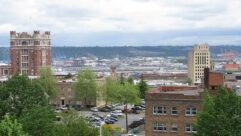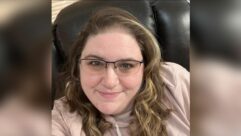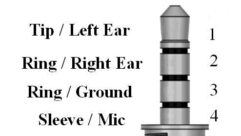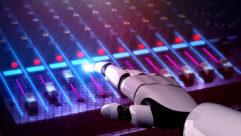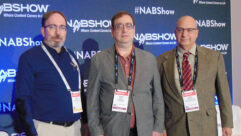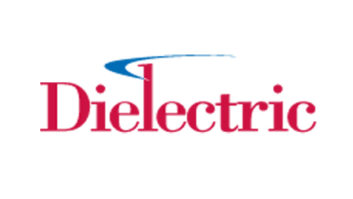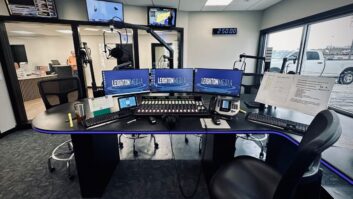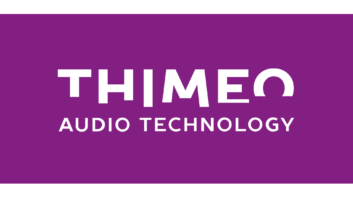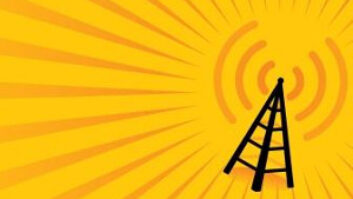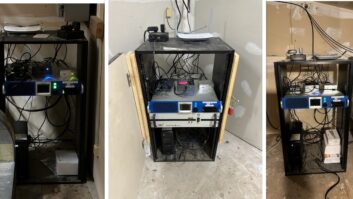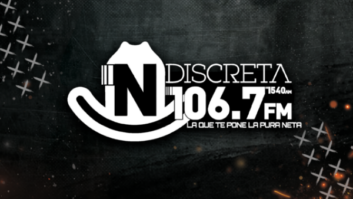Does FM single-sideband suppressed-carrier modulation outperform conventional double-sideband suppressed-carrier modulation?
Many observers say the evidence in favor of FM SSBSC is anecdotal and that more rigorous testing is needed. Now the debate has taken the next step, with more testing to be conducted.
Frank Foti, president of Omnia Audio, has always liked to give impressive comparison demonstrations at his NAB Show presentations over the years. An audio clip of Greater Media’s WMJX(FM) in Boston — played at this year’s convention, showing dramatic FM reception improvement with SSBSC — did not disappoint. Find a link to the video at radioworld.com/July-04-2012.

FM System Noise Plot. Images are from Frank Foti’s presentation to the NAB Broadcast Engineering Conference. Credit: Images © NAB That clip was one of a number of road test comparison recordings conducted by WMJX engineers in difficult multipath areas of suburban Boston.
Greater Media Vice President of Engineering Milford Smith told RW, “The single drive test … was never intended to be the poster child for SSBSC. Its primary purpose was to provide an exhibit accompanying a report to the FCC for the experimental authorization issued to us by the commission.”
Besides the Greater Media tests, a number of significant stations and experienced engineers have tested SSBSC. Most whom we contacted said SSB does generally perform better. These include Mike Oberg of Zoe Communications, Brian Kerkan of the Cayuga Broadcast Group and Gary Kline of Cumulus Media, which is using SSB at several stations.
Dave Whitehead at KBHH(FM), in Fresno, Calif. says that without SSB, he can’t even properly reach part of his service market area with a listenable signal.
BENEFITS
SSBSC is a different way of adding stereo to FM broadcast transmissions. The conventional DSBSC method modulates the 38 kHz stereo subcarrier with both a lower sideband (23 to 38 kHz) and an upper sideband (38 to 53 kHz); SSBSC does not generate the upper sideband.
In 1987, Bob Tarsio, a longtime New York City broadcast engineer and president of Broadcast Devices, studied and wrote about SSBSC as an alternate method of generating FM stereo, one that potentially can achieve reduced noise and multipath. Other engineers — including Bill Gillman, chief engineer with Gentner Electronics in 1997, and more recently Brian Beezley, a retired design engineer, along with Foti and Bob Orban — have evaluated the technology in detail, as RW reported in our March 28 issue.
The underlying theory of why SSB appears to perform better is based on the realization of less bandwidth of the RF carrier, thanks to a reduction in sideband pairs within the FM channel. Sideband pairs are generated based upon the highest frequency transmitted. DSB will generate a spectrum of up to 53 kHz, whereas SSB only requires 38 kHz; this is where the reduction in sideband pairs occurs.
Less RF bandwidth equates to fewer signals becoming annoyed during instances of multipath.
Foti states, “Under program modulation and because of the triangular 6 dB/octave rising noise characteristic of the FM stereo sub-channel, the perceived SNR improvement is closer to 10 dB.” Further, he says, “There is a significant reduction in multipath artifacts and reduced interference to SCA and RDS reception.”
Omnia said station personnel in a dozen or so markets have conducted field tests using Omnia.11 or Omnia.9 processors and reported the results. These boxes have a firmware upgrade that enables SSB.
Foti said the results largely confirmed that SSB in its modern implementation appears to perform better than DSB and is compatible with proper stereo decoding on most receivers being used by consumers. Only a few models have been identified as possibly blending to mono more quickly with SSB.
NYC FIELD TESTS
However the idea has critics. They include Tarsio and Beezley. Since Foti’s 2010 paper and user field testing, those two engineers, working independently of one another, have examined SSB vs. DSB performance using mathematical analysis and multipath generation modeling. They have emerged as perhaps the most notable and outspoken naysayers in the debate.

Recovered Noise, DSB After modeling SSB and presenting the findings in his 1987 NAB paper, Tarsio spent considerable effort testing SSBSC in the field on three New York City FM stations. His methodology included the use of a modified Optimod 8100 using normal programming received on several stock models of car radios.
“My own anecdotal testing, which went on for a period of six years, did not yield dramatic improved results with SSB,” Tarsio said. “Quite to the contrary, what we encountered was an increase in noise ‘in close’ to the transmitter site, within five miles. My mathematical treatment … indicates that this should have been the expected result.”
Tarsio has written a paper that clarifies his original analysis; it includes multipath simulation using discrete tone modulation. A link is posted at radioworld.com/July-04-2012.
“It is my conclusion that the proposed SSB stereo system seems to indicate that there is not a significant benefit to reception. In fact in some cases it may actually provide worse reception characteristics due to dynamic modulation conditions.”
Beezley is a software/hardware design engineer who has worked in the past as a consultant to DaySequerra. Recently he applied analysis and modeling skills developed writing simulation software and designing real-time DSP systems to improve the performance of FM receiving systems. His writings on SSB and other topics are available at ham-radio.com/k6sti/index.html.
Beezley has criticized Foti’s claims about SSBSC, saying they are not mathematically provable. “I read Foti’s article in RW in the fall of 2010 and immediately realized that his assertion that there was no stereo separation penalty for SSB was false,” he said. “I was so appalled at the unscientific nature of the SSB YouTube video, the absence of quantitative experimental results and at the hand-waving offered as theoretical justification for an SSB multipath advantage that I decided to write the simulation to see what I could determine for myself.”

Recovered Noise, SSB Beezley offered a critique of the WMJX video clip: “The tests were made on different days. VHF propagation sometimes changes in minutes, and can easily change in an hour. This factor alone is enough to invalidate the tests. I have conducted many tests of multipath propagation. Its most general properties are its variability and instability. These must be taken into account in any real-world test by verifying that propagation has not changed during the test period. Otherwise the results are worthless.”
Responding, Foti said: “We ran in-field tests, independent of the WMJX tests, using a plotted route, and constant speed, where known multipath existed. Then we did an immediate A/B switch between DSB and SSB along the route, and captured the results. One of those examples was demonstrated during the NAB presentation. In all cases the SSB signal contained noticeably less multipath. This example eliminated any quandary about achieving different results on a different day, atmospheric conditions or propagation effects.”
Milford Smith says the WMJX SSB field tests were controlled and repeatable and defends their methodology.
“We do have other examples and intend to collect additional samples. All of these are collected in the same manner. Generally we select a route over which multipath is known to be present. The route is driven twice in the same direction, at the same speed — with and without SSBSC — and the audio and video from both runs is recorded. A conventional HD receiver and a likewise typical factory installed antenna are used for the tests.”
Smith also is unequivocal about SSB’s advantage over DSB in most of their tests: “We did not encounter any areas to date where DSB was judged to be superior to SSB. There were many areas where the performance of both was roughly equivalent. The example being circulated probably exhibited the most improvement noted in our limited testing.”
Like Tarsio’s mathematical analysis, Beezley’s modeling suggests that SSB offers no consistent advantage over DSB.“They indicate that the system that best suppresses multipath distortion depends on the delay and amplitude of the multipath replica,” Beezley stated. “Sometimes DSB is better, sometimes SSB. Averaged over a wide range of delays and amplitudes, the simulation shows no significant advantage for one system or the other. But for a particular propagation situation, one may work better.”
Foti believes Tarsio’s early over-the-air tests in New York were not capable of demonstrating SSB’s advantages fully because Tarsio used legacy analog SSB generation and processing equipment.
“Our digital implementation does not suffer from any lost modulation, due to overshoots, whereas the Tarsio method required a reduction of overall modulation — due to overshoots that were hard to manage in an analog implementation — and it’s quite possible the reduced modulation level … may have brought on other reception issues that gave the impression of exaggerated multipath,” Foti said.
“Recall, Bob Tarsio’s tests were done 25 years ago, and I believe much of those results do not hold up in today’s environment. We can accomplish so much more doing this in the digital domain with DSP, as compared to the analog implementation Bob did back in the 1980s.”
MODELING VS. FIELD TESTS
Bob Orban appears to agree with that assessment.
“Because Tarsio’s SSB generator of necessity used an analog 90-degree phase difference network with non-linear group delay, there may have been additional modulation overshoot artifacts.”
Orban offered the following observations regarding Beezley’s SSB vs. DSB mathematical analysis:
“Beezley’s model is accurate for the transmitter side. He did not simulate a radio that uses one of the many multipath mitigating algorithms used by real-world radios, although he did model a real IF. His multipath simulation was not necessarily as complex as a real-world scenario. … He discovered multipath scenarios where SSB was better and also scenarios where it was worse, assuming a relatively simple receiver with a real-world IF but no signal-dependent blend or other multipath mitigating algorithms. Because multipath creates nonlinear distortion in the FM detector, superposition does not hold and use of multiple tones will not necessarily predict what a radio would sound like with real program material.”
Foti sought to counter Beezley’s simulations by running real-world stereo separation tests with the same equipment Beezley cited. He found a “huge” disparity between the Beezley simulations and the actual system tests. His NAB presentation offered a few examples of these differences. Foti contends Beezley has not validated his methodology by comparing it to a known end-to-end actual system.
Radio World asked all of the engineers involved in the debate what they thought might be the basis for the disparity between the math modeling and the real-world field tests that have demonstrated SSB’s apparent advantage.
Both Tarsio and Beezley state there should not be a disparity or any such advantage for SSB. Orban suggests, “It is possible that the problematic areas in the Foti/Greater Media tests were those where the details of the multipath (delay time and magnitude of the reflected wave) happened to make the situation better.”
Other factors may be involved. The Tarsio and Beezley models and the early Tarsio field tests included only pure SSB transmission. The current Omnia.9 and .11, and the Orban 8600 processors, employ a vestigial sideband approach, in which the first 150 Hz to 200 Hz of audio spectrum modulates the 38 kHz stereo subcarrier with DSB. According to Foti and Bill Gillman, this technique helps to preserve stereo separation depth, mitigates early blend-to-mono and should reduce multipath distortion in receivers.
Foti asserts, “There’s a huge difference between simulations using steady state tones, and on-air tests with dynamic program material. Multipath behaves extremely differently between the two. Remember, multipath generally occurs on a short-term momentary basis, and dynamic program audio exists in a random manner too. Making a correlation about multipath using tones as compared to program material is a bit ponderous.
“There might be some merit to the simulated results — if an all-tone broadcast format were to exist.”
Another consideration is the effect of psychoacoustic noise masking under heavy modulation. Listeners do not hear noise and multipath artifacts as easily on a densely modulated and peak-limited transmission as they would on a less processed signal.
NRSC ACTION
But people with an interest and stake in SSBSC seem to agree on one thing: More theoretical and field testing is needed to better understand what is really going on.
At the NAB Show, the National Radio Systems Committee established a task group of the AM and FM Analog Broadcasting Subcommittee to tackle this assignment. Bert Goldman, a former broadcast director of engineering and now vice president of engineering consultancy Independence Broadcast Services, chairs the task group.
Orban offered ideas regarding how testing should proceed:
“I believe that NPR Labs has the best available equipment to do the tests, as they have a full-bore multipath simulator that can include Rayleigh fading. Doing the tests properly requires total repeatability between the SSB and DSB transmissions, so exactly the same RF path degradations occur at exactly the same time in the audio program material used for testing.”
Foti said Omnia engaged the services of NPR Labs and specifically its senior technologist John Kean, who determined that SSBSC does not cause any increased co-channel interference. That was the most important hurdle to be cleared so the FCC would grant experimental STAs to stations that want to test SSBSC over the air, according to proponents.
Regarding further testing, Orban said, “Getting valid results absolutely requires double-blind testing of the multipath-induced audio quality degradation at the output of the receiver.” Orban plans to join the NRSC AM and FM Analog Broadcasting Subcommittee and said, “I am keeping an open mind about this, but I am unwilling to be convinced without rigorous testing. Anecdotal evidence is interesting but insufficient.”
Foti says he’s in full agreement. “I’ve made requests to the NRSC about how to go about testing this. They listened, and now we’re about to embark on what testing is needed. In the meantime, it was also suggested by NRSC to go out and see if the concept has merit. We’ve done that, and based on comments from broadcasters, it does.”
Tom McGinley is technical advisor to Radio World. Comment on this or any story. Email [email protected], with “Letter to the Editor” in the subject line.
